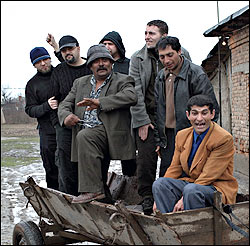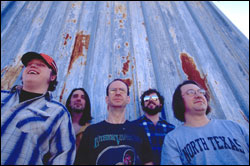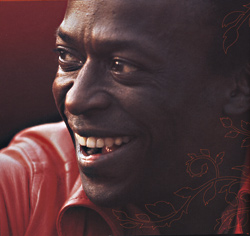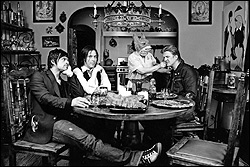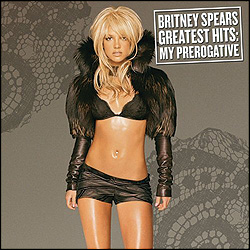There’s a definitive book yet to be written about the musical inbreeding between African Americans and Eastern Europeans, and Garth Cartwright is too restless to write it. That doesn’t stop the New Zealand raconteur from invoking the ghostly whispers of rural bluesmen as he surveys the countryside villages of the Roma Gypsies. Cartwright’s Princes Amongst Men: Journeys With Balkan Musicians (Serpent’s Tail, $20) includes a great discography, as you might expect; an even better filmography, as you might not; and a solid bibliography that’s maybe a little too convinced that Elvis Presley biographer Peter Guralnick and pan-American folklorist Alan Lomax can provide insight into the brassy wedding bands and breakneck rustic fiddling of the Balkans.
Then again, there’s a definitive book to be written about a bumptious gadje (as the Roma dub foreigners) eating, drinking, and kvetching his way from Macedonia to Bulgaria; Cartwright’s stamina, garrulous personality, and old-school romantic decadence suit the task ideally. Though his blog-worthy detailing of travel arrangements and the state of his passport can annoy, his mundane focus counterbalances the macro-political sweep of most reportage, providing a view of the region’s post-communist aftershocks—particularly those caused by the dissolution of Yugoslavia—from the muddiest of ground levels.
And we need it. Gypsy music once trickled into the U.S., with Romanian old-timers Taraf de Haidouks occupying the token slot in any world-music dilettante’s CD changer. Now, labels like Piranha and Asphalt Tango have doused the Western market with Balkan romps, and Cartwright’s interviews with Roma legends like Saban Bajramovic and Esma Redzepova provide essential context.
Ah, Saban and Esma: the James Brown and Aretha Franklin of Gypsy music, our guide calls ’em, and who knows—maybe some Bucharest Eminem fan might have as hard a time relating to the Godfather and the Queen as I do to the tracks representing these aging stars on World Music Network’s spotty 2004 Rough Guide to the Music of the Balkans. Cartwright’s passing mention that Whitney and Mariah are the Balkan gold standard for Western pop cleared up the roots of my resistance—melodramatic emphasis on florid vocal technique knows no borders. Yet when the old folks resurface on the same label’s brand-new Rough Guide to the Music of the Balkan Gypsies (how to identify it from the earlier collection: the first one’s red, this one’s green), they sound so much livelier, and not just because of the Dixieland wailing behind Redzepova, and not just because they aren’t plopped amidst Croatian folk and Bulgarian chorales.
No, it’s the new breed who carry The Rough Guide to the Music of the Balkan Gypsies: Preceded by the jazzy piano of Romanian teen idol Nikolae Simion on “Di, Murgule, Di,” Bajramovic sounds quaintly good- natured, like Grandpa weaving drunkenly up to the mike at your wedding. Yet the collection’s true scene-stealers are Mahala Rai Banda, second-gen Haidouk-lings who start the party with “Mahalageasca,” a busy crisscross of horns that sounds like a work of genius even before it reaches its near-vaudevillian ragtime breakdown.
A cosmopolitan lot, members of Mahala are also behind the much-disparaged Electric Gypsyland (Six Degrees), on which well-meaning gadje electronically rework the rhythms of some willing Romamusicians. But the band’s own recording, Mahala Rai Banda (Crammed), is a more successful flirtation with the world beyond the village, often with a North African flavor—”Red Bula” is, at moments, practically an Arab “Macarena.”
Ah, yes, but is it the Gypsy blues— or better yet, given all those horns, jazz? Louisiana was, in fact, a major destination for many Roma immigrants to the U.S, and if they played anything like Romania’s Fanfare Ciocarlia on Gili Garababdi: Ancient Secrets of Gypsy Brass (Asphalt Tango), their marching band synchronization might have tugged at the ear of a black cornetist or two. But maybe the cause of such similarities predates the American melting pot—after all, the West African styles that provided a seedling for the blues were inflected by Islamic modal scales, an influence the Roma encountered every step of the way in their long trek from India to the Balkans. And as the Boban Markovic Orkestar‘s brilliant swerve of sour harmonies and eccentric counterpoint on Boban I Marko (Piranha) makes clear, Gypsy music is too elastic and omnivorous to pin down stylistically. A rhythmic pattern suggests that “Biseri Srbije, Part 2” could become the Beatles’ “Michelle” at any minute; instead, one of the trumpeting Markovics (either boss Boban or his son Marko) blasts into “Over the Rainbow.”
And even the most fluid Gypsy music has only passing acquaintance with Africa’s diasporan gift to humanity—the groove. The electronic beats running beneath the rough-hewn bear-training chants of the Shukar Collective on Urban Gypsy (Riverboat) aim instead for hypnotic or jagged. It’s often claimed that the Roma are the blacks of Europe, but if that means anything, it’s that like all “primitive” “outsiders,” Gypsies provide an ideal screen on which other cultures can project their desires of freedom. So it makes sense that the twin rampant evils of nationalism and tribalism would spark interest in the history of a transnational race who adopt the cultural inflections of the societies they come in contact with, and the future of a cosmopolitan people in a world of stricter border patrols.
It’s also telling that on their amazing new Gypsy Punks: Underdog World Strike (Rubric), America’s premier Gypsy-music revisionists, New York’s Gogol Bordello, explore international confluences (especially pan-Arab) rather than digging into hip-hop or its earthier predecessors. In the polyphonic frenzy of the Gypsies, there’s a lesson on how to adjust to a world that’s bigger and messier than the blues ever imagined.
